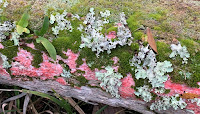 |
A moment of non-social distancing
with Libbie and Deb |
Florida has many, many issues, but winter weather isn't one of them. Being able to comfortably enjoy the great outdoors in this winter of Covid is particularly appreciated. And so I was off this week on an outing with friends to Myakka River State Park. It was great fun.
It had been ten years since I last visited Myakka with a group from the Isles Yacht Club. In my defense, it was kind of a long drive when I lived in Punta Gorda. I was surprised to realize the Park is less than 30 minutes from my Sarasota home -- essentially two turns. My bad.
It didn't take long to realize it's pretty handy to have a couple of naturalists with you when you're on a walk through old Florida at its finest. "Wow, look at that pink stuff on that tree," I commented early on. It looked like an artist had been out with a paint brush using a fallen tree limb as her canvas. "Oh, that's lichen," Libbie shared. (Lichen, as you surely know, is a moss-looking organism comprised of algae and a fungus.) It's pretty.
 |
| Carole navigating the walkway |
Eventually, we found ourselves at the Canopy Walkway for which Myakka is known. The Walkway was the first public treetop walkway in North America and extends 100 feet through the hammock canopy. It was constructed in 2000 at a price tag approaching $100,000. The maintenance fund was being put to good use when we arrived as a guy was clearing the steps and the walkway with a leaf blower. It seemed like a bit of an uphill battle, but leaves can definitely be a safety concern.
You can either enjoy the view from the Walkway or continue your climb to the observation tower. (There's a total 116 stairs. I counted.) Our non-profit fundraising brains immediately noticed that each plank on the climb had been a naming opportunity. The planks on at least three levels of the stairway had been sponsored by Peruvians. I'd love to know the story behind their visit. My favorite name plate read: "Howie & Allison Madsen kissin' in a tree." The cynic in me hoped they haven't gotten divorced.
 |
| The view is worth the climb! |
When we arrived at the final landing, the view would have made us breathless if we weren't already. Laid out below was a canopy of tree tops that extended as far as the eye could see. It's kind of weird -- and pretty awesome -- to have that vantage point.
As lovely as the scene was, we weren't able to appreciate the details of the view. Nary a one of us had remembered to bring binoculars. Nor had we thought to bring a pocketful of quarters to use the telescope. (I would really like to know if anyone is sufficiently prepared for that.) Note to self for next visit.
 |
Bittern
Photo by Libbie Sherman |
From there we moved on to the Birdwalk, located in a freshwater wetlands area particularly appealing to our feathered friends. The Birdwalk was part of the original park built in the 1930s by the Civil Corps of Engineers.
As we walked out to the viewing area, all I could see was a bunch of reeds. But eagle eye Deb caught side of an American bittern. It was oh so sweet. The bird wasn't self-conscious at all as we watched it hunt for lunch. It thrust its neck forward when it went for something yummy, and its stomach expanded like a small balloon as the treat went down. A little study of nature right in front of us.
 |
| Roseate Spoonbill |
Later we saw a bowl of roseate spoonbills. (Yes, that's the name for a group of these beautiful birds.) There were at least 25 of them hanging out on the opposite shore next to some alligators enjoying the sun. Yikes!
Roseate spoonbills are an eye-catching breed due to their colorful plumage and bills that are shaped like, well, a spoon. Interestingly, these birds aren't born with their signature bills. Over the course of six weeks following a spoonbill's birth, its bill flattens out, changes into a spoon-like shape and grows to its full size. Like flamingos, their unique coloring comes from their diet. In the late 19th century, roseate spoonbills faced extinction in North America due to the popularity of their feathers for use in hats, fans and screens. But groups like the National Audubon Society stepped in and established preserves for the birds. They became a protected species in the 1940s. The efforts were so successful that they no longer require this special status.
It was a great outing. Next time I'll go on one of the tram or boat tours and see what other tidbits I can pick up. And now I'm off for a walk.
Stay safe!






